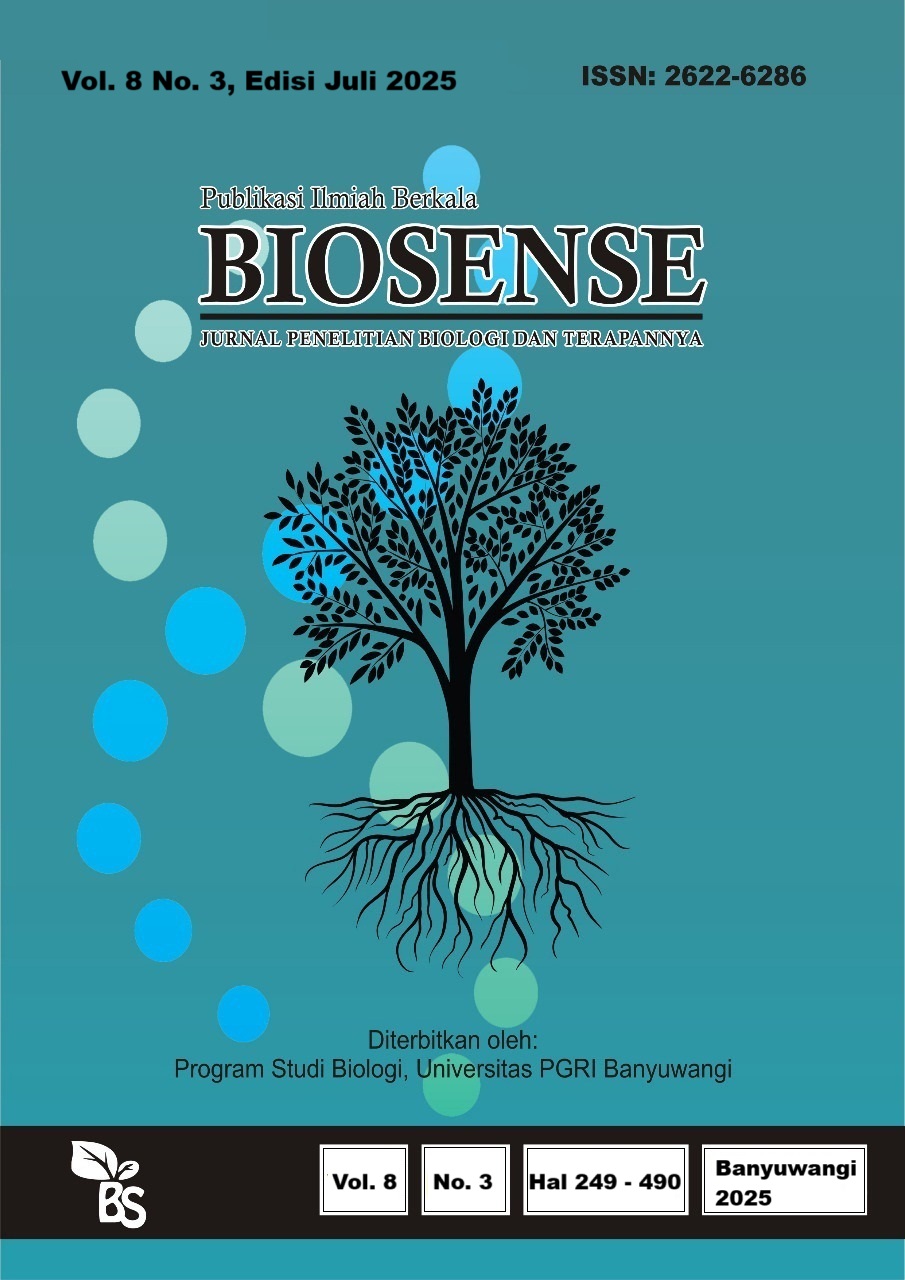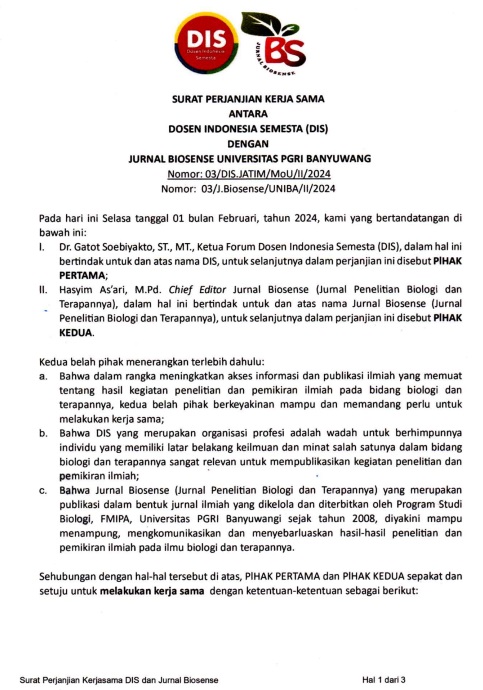REVIEW: POTENSI BAKTERI ASAM LAKTAT (BAL) UNTUK MENINGKATKAN MUTU PRODUK PANGAN
DOI:
https://doi.org/10.36526/biosense.v8i3.5219Keywords:
Bakteri Asam Laktat, Fermentasi, Produk Pangan, Probiotik, BakteriosinAbstract
Bakteri Asam Laktat (BAL) merupakan mikroorganisme penting yang dimanfaatkan secara luas dalam industri pengolahan pangan. Fermentasi bahan pangan menggunakan BAL memberikan manfaat signifikan dalam meningkatkan nilai gizi, cita rasa, sebagai probiotik, dan agen biopreservatif menjadikannya komponen kunci dalam proses produksi berbagai olahan pangan yang aman serta berkualitas tinggi. BAL memfermentasi bahan pangan dengan mendegradasi karbohidrat menjadi asam laktat (homofermentatif) atau menjadi campuran asam laktat, karbon dioksida, asam asetat dan/atau etanol (heterofermentatif). Bakteri ini mampu memproduksi bakteriosin yang memiliki aktivitas antimikroba sebagai alternatif yang layak untuk pengawet makanan. Seiring kemajuan di bidang rekayasa genetika, dan meningkatnya permintaan akan penggunaan BAL dalam industri pangan mendorong perlunya upaya yang signifikan dalam modifikasi genetik metabolisme mikroorganisme melalui pengembangan strain BAL baru yang dapat meningkatkan kualitas makanan industri.
References
Ardilla, Y. A., Anggreini, K. W., & Rahmani, T. P. (2022). Peran Bakteri Asam Laktat Indigen Genus Lactobacillus Pada Fermentasi Buah Durian (Durio zibethinus) Sebagai Bahan Pembuatan Tempoyak. Berkala Ilmiah Biologi, 13(2), 42–52.
Asgher, M., Qamar, S. A., Bilal, M., & Iqbal, H. M. N. (2020). Bio-based active food packaging materials: Sustainable alternative to conventional petrochemical-based packaging materials. In Food Research International (Vol. 137). Elsevier Ltd. https://doi.org/10.1016/j.foodres.2020.109625
Cho, S. W., Yim, J., & Seo, S. W. (2020). Engineering Tools for the Development of Recombinant Lactic Acid Bacteria. In Biotechnology Journal (Vol. 15, Issue 6). Wiley-VCH Verlag. https://doi.org/10.1002/biot.201900344
Coelho, M. C., Malcata, F. X., & Silva, C. C. G. (2022). Lactic Acid Bacteria in Raw-Milk Cheeses: From Starter Cultures to Probiotic Functions. In Foods (Vol. 11, Issue 15). MDPI. https://doi.org/10.3390/foods11152276
Daba, G. M., & Elkhateeb, W. A. (2020). Bacteriocins of lactic acid bacteria as biotechnological tools in food and pharmaceuticals: Current applications and future prospects. In Biocatalysis and Agricultural Biotechnology (Vol. 28). Elsevier Ltd. https://doi.org/10.1016/j.bcab.2020.101750
Fernandez, B., Vimont, A., Desfossés-Foucault, É., Daga, M., Arora, G., & Fliss, I. (2017). Antifungal activity of lactic and propionic acid bacteria and their potential as protective culture in cottage cheese. Food Control, 78, 350–356. https://doi.org/10.1016/j.foodcont.2017.03.007
Gupta, R., Jeevaratnam, K., Fatima, A., Scholar, P., & Graduate, P. (2018). Lactic Acid Bacteria: Probiotic Characteristic, Selection Criteria, and its Role in Human Health (A Review) (Vol. 5). JETIR. www.jetir.org
Han, X., Yang, Z., Jing, X., Yu, P., Zhang, Y., Yi, H., & Zhang, L. (2016). Improvement of the Texture of Yogurt by Use of Exopolysaccharide Producing Lactic Acid Bacteria. BioMed Research International, 2016. https://doi.org/10.1155/2016/7945675
Hasbi, N., Rosyunita, R., Rahim, A. R., Parwata, W. S. S., Ayunda, R. D., Farras, A., Raihan, A. F., & Billah, M. A. (2024). ISOLASI DAN IDENTIFIKASI BAKTERI ASAM LAKTAT ASAL FESES BAYI SECARA FENOTIPIK. Prosiding SAINTEK, 6, 101–109. https://doi.org/10.29303/saintek.v6i1.924
Ismail, I., Mubarak, F., Rasyak, R. I., Rusli, R., Fitriana, F., & Mashar, H. M. (2023). Isolasi dan Uji Aktivitas Bakteri Asam Laktat dari Produk Fermentasi Kombucha Teh Dalam Menghambat Bakteri Escherichia coli, Staphylococcus aureus, dan Salmonella thypi. Jurnal Mandala Pharmacon Indonesia, 9(2), 335–344. https://doi.org/10.35311/jmpi.v9i2.386
Korcz, E., & Varga, L. (2021). Exopolysaccharides from lactic acid bacteria: Techno-functional application in the food industry. In Trends in Food Science and Technology (Vol. 110, pp. 375–384). Elsevier Ltd. https://doi.org/10.1016/j.tifs.2021.02.014
Lee, K. wook, Kim, G. S., Baek, A. H., Hwang, H. S., Kwon, D. Y., Kim, S. gu, & Lee, S. yun. (2020). Isolation and Characterization of Kimchi Starters Leuconostoc mesenteroides PBio03 and Leuconostoc mesenteroides PBio104 for Manufacture of Commercial Kimchi. Journal of Microbiology and Biotechnology, 30(7), 1060–1066. https://doi.org/10.4014/jmb.2001.01011
Li, Q., Wang, X., Guo, S., Wang, T., Cao, H., Cao, Y., & Dong, B. (2025). Galacto-oligosaccharides alleviate experimental lactose intolerance associated with gut microbiota in mice. Frontiers in Microbiology, 16. https://doi.org/10.3389/fmicb.2025.1530156
Masalam, M. S., Bahieldin, A., Alharbi, M. G., Al-Masaudi, S., Al-Jaouni, S. K., Harakeh, S. M., & Al-Hindi, R. R. (2018). Isolation, Molecular Characterization and Probiotic Potential of Lactic Acid Bacteria in Saudi Raw and Fermented Milk. Evidence-Based Complementary and Alternative Medicine, 2018(1). https://doi.org/10.1155/2018/7970463
Mokoena, M. P. (2017). Lactic acid bacteria and their bacteriocins: Classification, biosynthesis and applications against uropathogens: A mini-review. In Molecules (Vol. 22, Issue 8). MDPI AG. https://doi.org/10.3390/molecules22081255
Nuraida, L. (2015). A review: Health promoting lactic acid bacteria in traditional Indonesian fermented foods. In Food Science and Human Wellness (Vol. 4, Issue 2, pp. 47–55). Elsevier B.V. https://doi.org/10.1016/j.fshw.2015.06.001
Peng, K., Koubaa, M., Bals, O., & Vorobiev, E. (2020). Recent insights in the impact of emerging technologies on lactic acid bacteria: A review. In Food Research International (Vol. 137). Elsevier Ltd. https://doi.org/10.1016/j.foodres.2020.109544
Raj, T., Chandrasekhar, K., Kumar, A. N., & Kim, S.-H. (2022). Recent biotechnological trends in lactic acid bacterial fermentation for food processing industries. Systems Microbiology and Biomanufacturing, 2(1), 14–40. https://doi.org/10.1007/s43393-021-00044-w
Samedi, L., & Charles, A. L. (2019). Isolation and characterization of potential probiotic Lactobacilli from leaves of food plants for possible additives in pellet feeding. Annals of Agricultural Sciences, 64(1), 55–62. https://doi.org/10.1016/j.aoas.2019.05.004
Xiang, H., Sun-Waterhouse, D., Waterhouse, G. I. N., Cui, C., & Ruan, Z. (2019). Fermentation-enabled wellness foods: A fresh perspective. Food Science and Human Wellness, 8(3), 203–243. https://doi.org/10.1016/j.fshw.2019.08.003
Xie, Z., McAuliffe, O., Jin, Y.-S., & Miller, M. J. (2024). Invited review: Genomic modifications of lactic acid bacteria and their applications in dairy fermentation. Journal of Dairy Science, 107(11), 8749–8764. https://doi.org/10.3168/jds.2024-24989
Yusuf, D., Nuraida, L., Hariyadi, R., & Hunaefi, D. (2020). Lactic Acid Bacteria and Yeasts From Indonesian Kefir Grains and Their Growth Interaction. Asian Journal of Microbiology, Biotechnology & Environmental Sciences Paper, 22(1), 44–49.
Zheng, J., Wittouck, S., Salvetti, E., Franz, C. M. A. P., Harris, H. M. B., Mattarelli, P., O’toole, P. W., Pot, B., Vandamme, P., Walter, J., Watanabe, K., Wuyts, S., Felis, G. E., Gänzle, M. G., & Lebeer, S. (2020). A taxonomic note on the genus Lactobacillus: Description of 23 novel genera, emended description of the genus Lactobacillus beijerinck 1901, and union of Lactobacillaceae and Leuconostocaceae. International Journal of Systematic and Evolutionary Microbiology, 70(4), 2782–2858. https://doi.org/10.1099/ijsem.0.004107
Downloads
Published
How to Cite
Issue
Section
License
Copyright (c) 2025 JURNAL BIOSENSE

This work is licensed under a Creative Commons Attribution-NonCommercial-ShareAlike 4.0 International License.

















